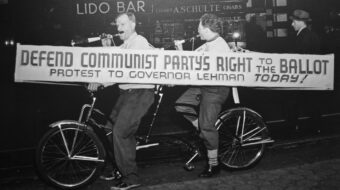The executive council of the AFL-CIO, the nation’s largest labor federation, called for a massive second economic stimulus package yesterday, modeled after FDR’s Works Progress Administration, noting that the agency put 3.5 million people to work in 1935 alone. The council, after a one-day meeting yesterday in Silver Springs, Md., declared:
“President Roosevelt’s strategy can be re-engineered to help revitalize the modern manufacturing sector by putting the jobless to work renovating factories and public structures, while others can develop financing and marketing plans to support domestic production and jobs.”
In addition to the WPA-type program the federation said the second stimulus plan must include an additional seven weeks or more extension of jobless benefits, another increase in food stamp benefits, more aid to state and local governments to prevent further layoffs and service cuts and more spending on infrastructure and clean energy products.
The federation said the measures are called for because the current recession is much deeper than anyone had first thought.
The call for the second stimulus was issued after the executive council met in a closed-door session with Jared Bernstein, a top economic aide in the Obama administration. During the session Bernstein talked about the administration’s pro-labor moves, said the first stimulus is slowly beginning to work and that the administration is not yet ready for a second stimulus.
AFL-CIO Policy Director Thea Lee said, in a phone interview, that Bernstein told the council that “one third of the stimulus money has been spent or is in the pipeline.” Lee said the union leaders directly pushed the administration spokesman for a second stimulus package and that “Bernstein said they’re not ready to talk about that yet.”
Labor has, of course, been more than ready to discuss a second stimulus.
Richard Trumka, AFL-CIO secretary-treasurer, has been calling for one for several months.
Earlier this month Trumka said the first stimulus, at $787 billion, was “too small for an economy with a 9.5 percent jobless rate, falling industrial production, rising foreclosures and declining gross domestic product.”
The union leaders went further in their warnings about the economy yesterday than they have gone in any statement thus far. Their statement said that, within 12 months, one third of all U.S. workers could end up finding themselves in either the category of unemployed or underemployed.
The executive council also announced plans for two big labor mobilizations in August – one on health care and another on the Employee Free Choice Act.
Both campaigns are intended to counter the on-going business backed efforts against both health care reform and labor law reform.
Sources say the labor leaders were angry about the decision of the Democratic-run 111th Congress, due to divisions within the Democratic majority, to put off final decisions on health care until after Sept. 8.
Even as the council was meeting unions were funneling 50,000 phone calls to members of Congress as part of a national day of action on health care reform.
Discussing the Employee Free Choice Act after the meeting, AFL-CIO Organizing Director Stewart Acuff said, “The important thing is to preserve the essential elements of the Employee Free Choice Act: Restoring the freedom to organize and bargain collectively. That’s the measure by which any tweaking of the law will be judged.”
The council itself reaffirmed the federation’s strong support for the bill’s majority sign-up provision, which calls for recognition of a union as soon as a majority of workers sign cards indicating that they want representation by that union.
Acuff said that alternatives to majority sign-up, including mail-in ballots, mail-in authorization cards and quick NLRB elections were not discussed much at the meeting but were also not ruled out. “These would be dramatically better than what we have now,” he said.
Current law allows long campaigns that give employers the opportunity to harass, intimidate and fire union organizers.
Senate sponsor Tom Harkin, D-Iowa, continues to insist that majority sign-up is still on the table. “Nothing is agreed to until everything is agreed to,” he is saying.
After the meeting AFL-CIO Legislative Director, Bill Samuel and AFSCME President Gerald McEntee described some of the discussion on health care reform.
“We reviewed what’s happened so far and talked about our success in beating back the idea of taxing health benefits,” Samuel said.
“But if the Senate Finance Committee decides to let employers off the hook and to ax the government run public option, we’ll have to see what to do,” said McEntee.
McEntee’s union, alone, has some 16,000 members out campaigning for health care with a strong public option and is running a national television ad campaign on the issue.









